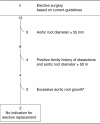Survival and complication free survival in Marfan's syndrome: implications of current guidelines
- PMID: 10490568
- PMCID: PMC1760285
- DOI: 10.1136/hrt.82.4.499
Survival and complication free survival in Marfan's syndrome: implications of current guidelines
Abstract
Objective: To evaluate survival and complication free survival in patients with Marfan's syndrome and to assess the possible influence of recently revised guidelines for prophylactic aortic root replacement in these patients.
Methods: 130 patients who had been attending one institution over 14 years were evaluated. Kaplan-Meier analysis was performed in 125 patients who did not present with aortic root dissection as the first sign of Marfan's syndrome, with the end points: death, aortic root dissection, and prophylactic aortic root replacement after diagnosis. In the patients developing aortic root dissection, current guidelines for prophylactic aortic root replacement were retrospectively applied to investigate the number of dissections that could theoretically have been prevented. The guidelines were: (1) aortic root diameter >/= 55 mm, (2) positive family history of aortic dissections and aortic root diameter >/= 50 mm, and (3) aortic root growth >/= 2 mm/year. Outcomes following emergency surgery (15 patients) and prophylactic surgery of the aortic root (30 patients) were compared.
Results: Five and 10 year survival after diagnosis was 95% and 88%, and the five and 10 year complication free survival was 78% and 66%, respectively. Thirteen patients developed dissection, 30 underwent prophylactic repair, and 82 had an uncomplicated course. Eleven dissections could theoretically have been prevented by application of the current guidelines. Five year survival following emergency and prophylactic repair of the aortic root was 51%, and 97%, respectively.
Conclusions: Survival in the Marfan's syndrome in the past 14 years seems satisfactory; with application of current guidelines, it has probably even improved. However, because of the high fatality rate in Marfan patients developing aortic root dissection, more extensive screening for Marfan's syndrome and a search for additional risk factors are desirable.
Figures




References
Publication types
MeSH terms
LinkOut - more resources
Full Text Sources
Medical
Miscellaneous
